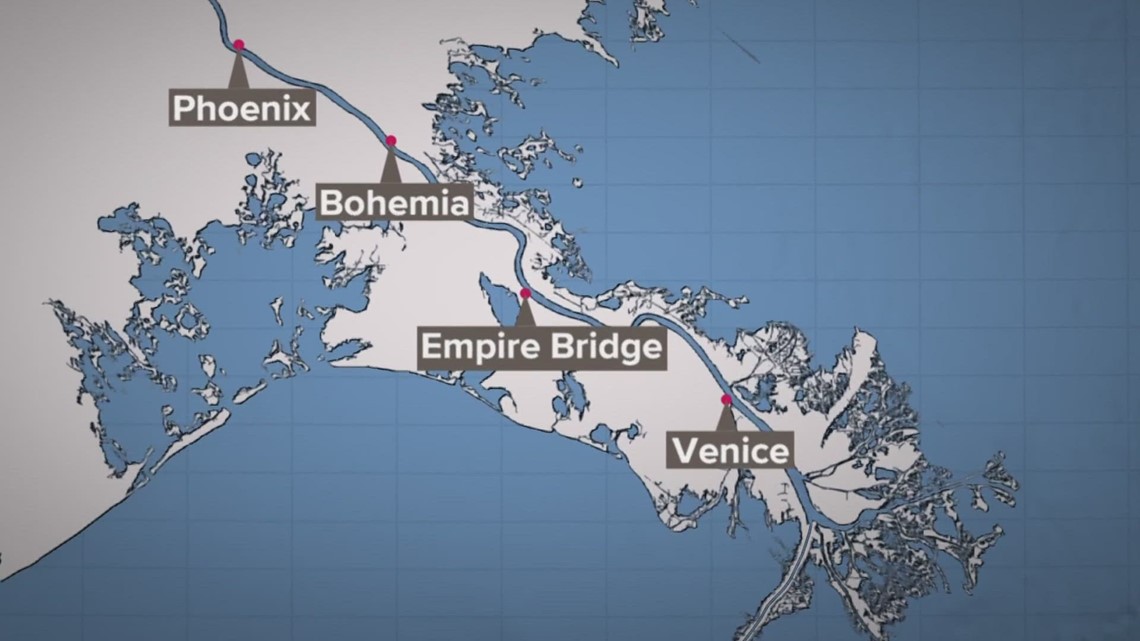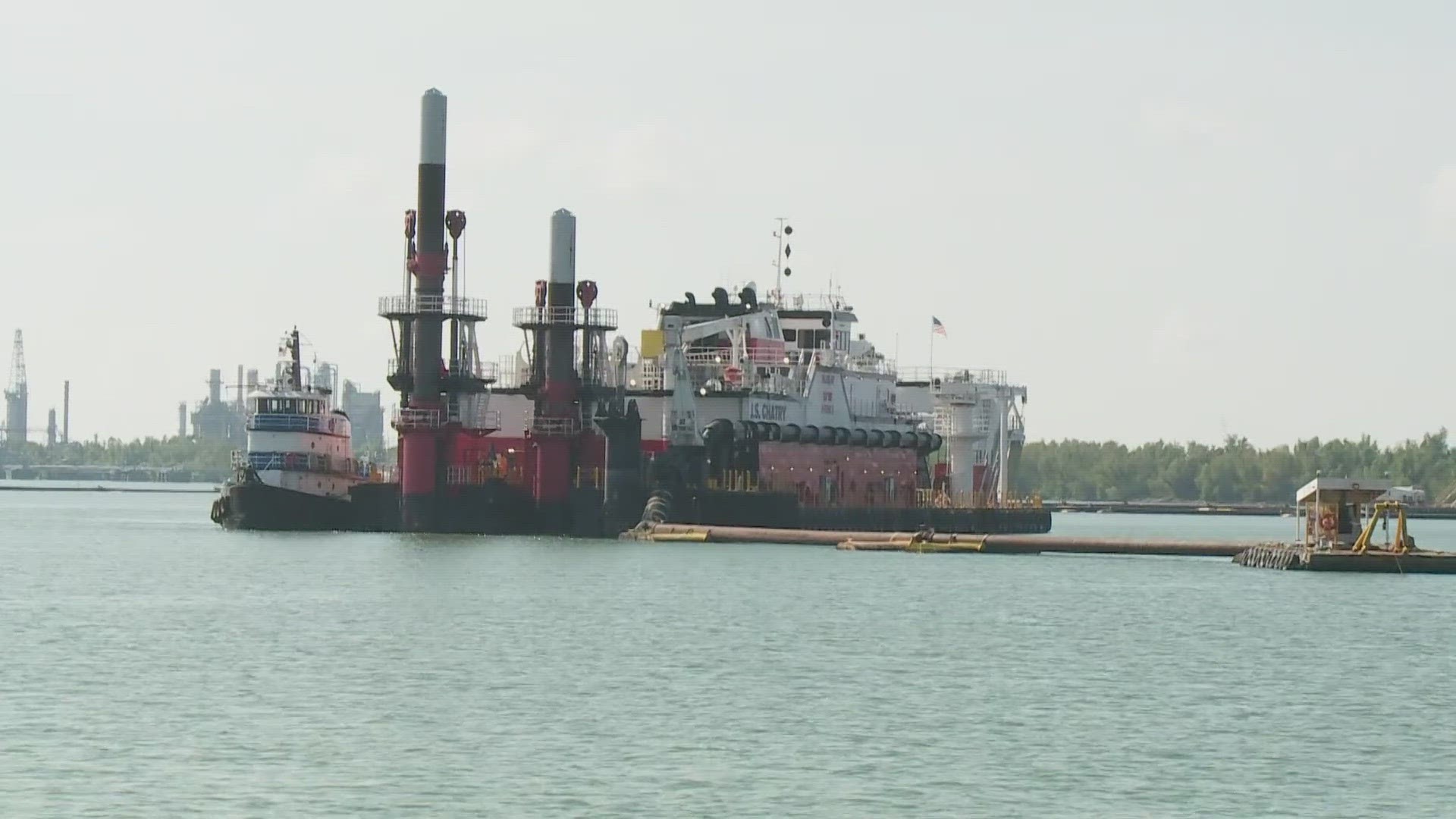NEW ORLEANS — Parish presidents in St. Bernard and Jefferson Parishes say they are preparing as a wedge of saltwater from the Gulf creeps up beneath the surface of the Mississippi River, threatening the parishes' water systems.
St. Bernard Parish President Guy Mcinnis tells Eyewitness News that parish emergency managers are making moves to mitigate the danger of salt contamination.
He says the parish is testing and monitoring the water salinity every day.
“Right now, as parts per million, right, and we don't want those parts per million to get up above 200 or 250. It becomes unsafe to drink at that point. So, in St. Bernard, we're still in the 30s and low 40s Belle Chase and Braithwaite is the same way,” Mcinnis says.
“When you get to Point a la Hache, it's up, you know, it's up around 250 to 260. We monitor that every day. We watched it come up the river, if you will, and we're going to be ready.”
He says the cooperation between the surrounding parishes impacted by the saltwater intrusion has been amazing.
“The Corps has been amazing. They increased our date from October 8 to the 19. That was a blessing in itself. So, we're working hard in three areas to connect to the city, the reverse osmosis and barging water here to St. Bernard Parish. So, we're trying to get ready for that, to be able to take the delivery of water from the Corp here.”
He also says one factor working in the parish's favor is that the parish water system intake is only 12 feet below the river surface, high above the saltwater wedge resting deep beneath the river.
“We're asking everybody to stay as calm as they can be. When you go to the grocery buy a couple of extra cases of water, we're going to have water to distribute to our citizens in case the water becomes unsafe. And it's just one of those things. We're working at it from all angles, and we hope we're ready for it,” Mcinnis says.


Jefferson Parish is also preparing to deal with the saltwater intrusion.
Parish President Cynthia Lee Sheng tells us that she and the parish emergency management team have been in contact with local grocery store distributors to ensure stores will be ready with plenty of bottled water available for sale.
“We hosted a call with all the local grocers and water distributors, just making sure that you know, I mean, that their regional managers, that the people who go into the store and are responsible for that store understand that when this thing approaches us, and it starts going to Algiers, the need for water increases exponentially,” Lee Sheng says.
“There are about 390,000 people in Orleans Parish. There are about 430,000 people in Jefferson Parish. For them to be ready for them to discuss with their supply chains, make sure they're ready to flex up to volume up, however, you want to say it very, very quickly. And I think I saw that, even Sunday, the grocery stores locally here started putting a lot of water at the front of the door because that's their way they play a key role in this for us is to keep people calm, and making sure that we always have availability of water.”
Sheng says right now the water is normal and that the parish is monitoring the water salinity levels every day at the parish's three river intakes.
She also says she recognizes that some options to deal with saltwater in the system, like reverse osmosis machines, may work well for smaller parishes but may not be as effective for a large parish like Jefferson.
“We are purchasing reverse osmosis machines, but many of the solutions that are available to the smaller parishes just are not available to us,” she says.
“We put out at least 70 million gallons a day, the reverse osmosis machines can handle about 320,000 gallons a day. So, that is not really available to us in terms of pushing out the water at the distribution site. We did order some machines just to have it, to just be able to, you know, make our own water for maybe our own employees or something. But that is not going to be a solution. For our actual distribution system. We're just too large of a system for reverse osmosis machines.”
Sheng tells us that barging water is also not a viable option because of the size of the parish but says her team is exploring alternatives.
She says the other parishes in the region are all coming together to help each other out in this crisis.
“There is no issue as regional as this. I mean, you know, if a hurricane comes, we're all working on issues, but we really have to help one another out. And really, this is a true regional effort,” she says.
“We've been supporting Plaquemines Parish, sending them up about 100,000 gallons a day. Grand Isle is going to be taken care of by Lafourche Parish. I think New Orleans is sending water to St. Bernard Parish So we're really getting, you know; this is a regional effort and whoever is upstream can help the downstream people.”
Several plans are in motion to keep the water safe to drink or use. On Monday, the Army Corps of Engineers started raising the height of the underwater sill on the bottom of the river from 55 feet to a depth of 30 feet. That work is expected to be completed in the next 24 days.
The Army Corps is also trying to gather a fleet of barges that would deliver fresh water to downriver treatment plants.
► Get breaking news from your neighborhood delivered directly to you by downloading the new FREE WWL-TV News app now in the IOS App Store or Google Play.

